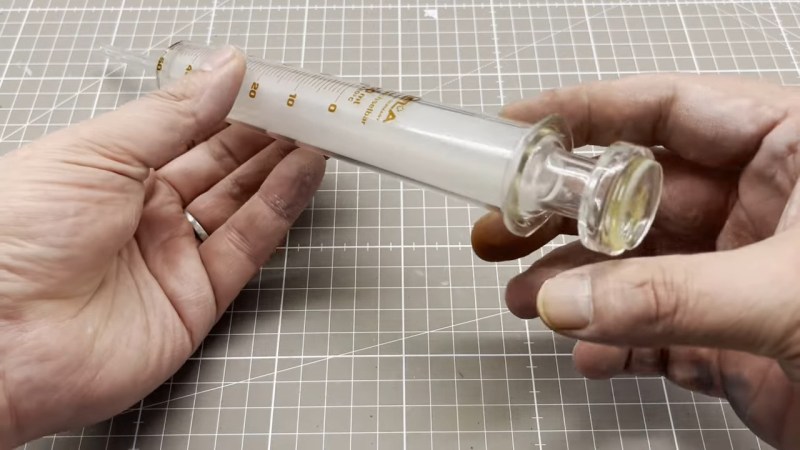How would you go about determining absolute zero? Intuitively, it seems like you’d need some complicated physics setup with lasers and maybe some liquid helium. But as it turns out, all you need is some simple lab glassware and a heat gun. And a laser, of course.
To be clear, the method that [Markus Bindhammer] describes in the video below is only an estimation of absolute zero via Charles’s Law, which describes how gases expand when heated. To gather the needed data, [Marb] used a 50-ml glass syringe mounted horizontally on a stand and fitted with a thermocouple. Across from the plunger of the syringe he placed a VL6180 laser time-of-flight sensor, to measure the displacement of the plunger as the air within it expands.
Data from the TOF sensor and the thermocouple were recorded by a microcontroller as the air inside the syringe was gently heated. Plotting the volume of the gas versus the temperature results shows a nicely linear relationship, and the linear regression can be used to calculate the temperature at which the volume of the gas would be zero. The result: -268.82°C, or only about four degrees off from the accepted value of -273.15°. Not too shabby.
[Marb] has been on a tear lately with science projects like these; check out his open-source blood glucose measurement method or his all-in-one electrochemistry lab.
















I love experiments like this. It shows how some perhaps mysterious scientific principles and concepts can be derived and illustrated using materials, tools, and techniques well within the grasp of hobbyists. How did scientists determine the temperature of absolute zero? Easy! They plotted how the volume of gas changed with temperature and extrapolated to zero volume.
Beautiful experiment! It will always amaze me how accessible fundamental science has become.
i’m upset at the idea that V=0 when T=0K even though it obviously pops right out of the ideal gas law PV=nRT. i guess it’s better think of it as ‘the gas law obviously breaks at this value of T’, and not to actually contemplate what happens (would happen) at absolute zero
The ideal gas law is so called because it only applies to ideal gases, i.e. far away from phase transitions.
exactly, which is why i’m skeptical of using it this way, or anyways, i don’t understand why
This has to be understood as a limit analysis. If T→ 0, V→ 0. This is a limit that can never be reached. But research shows that it is possible to get very close to this limit.
I never thought to question PV=nRT until reading this. A little thought shows that the law can only be an approximation, because V can never go to zero: the atoms/molecules of a gas have nonzero volume even when they’re not moving (and no longer a gas.) The wikipedia page on the ideal gas law mentions this and other problems.
Speculating, perhaps P(V-Vo)=nRT, where Vo is the minimum volume of the material.
I think instead of looking at it from an ideal gas law perspective, simply going with the definition of temperature as “average kinetic energy of the molecule” is insightful. If the temperature is zero, the average kinetic energy (aka speed or perhaps more accurately velocity) is also zero. Even a large mass with zero velocity has zero KE.
There are indeed correction factors to the Ideal Gas Law that involve both a volume correction like the one you propose (adjustment for the minimum space occupied by atoms) and a pressure correction (adjustment for intermolecular interactions and gas-container interactions).
That said, helium behaves very much like an ideal gas (largely because it is tiny and monoatomic)
Super cool experiment and decent results. I think, though, that his estimation of absolute zero is probably wayyyy better than claimed.
The claim of 268.82 C is to two decimals or 5 “digits” implying that measurement is accurate to +- like 0.01 degC which is probably preposterous given the nature of his measurements and apparatus . If he just claimed his measured results were accurate to 1% or even 0.3% ie 270 degC his answer would be dead-nuts on within the error of the experiment.
I think it amazing that syringe didn’t leak or add so much friction to ruin the experiment. I didn’t catch if he used any lubricant or sealant. Did he? Can’t grep a fscking video.
That is a ground glass “frictionless” syringe.
It is precision made and does not leak air. They are used in the medical field. I’ve personally used them and they kind of seem like magic.
Look up “labor epidural” or something like that for more information.